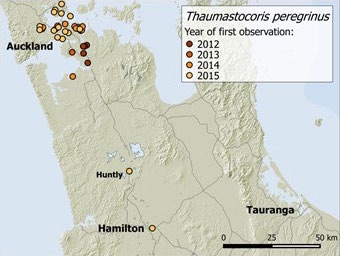PESTS AND DISEASES OF FORESTRY IN NEW ZEALAND
Update on the spread of bronze bug in New Zealand
Scion is the leading provider of forest-related knowledge in New Zealand
Formerly known as the Forest Research Institute, Scion has been a leader in research relating to forest health for over 50 years. The Rotorua-based Crown Research Institute continues to provide science that will protect all forests from damage caused by insect pests, pathogens and weeds. The information presented below arises from these research activities.
From Forest Health News 256, May 2015.
In April 2015 Scion scientists conducted a survey for bronze bug, Thaumastocoris peregrinus, and discovered that the bug had spread considerably beyond central Auckland. Three years since the original find, we now know it to be present from Auckland’s North Shore southward to Hamilton, a distance of approximately 130 km. Bronze bug is a eucalypt feeder originating from Australia and its feeding damage can lead to premature leaf drop, branch death, and in severe cases tree mortality.

These recent findings, along with earlier records found via the Ministry for Primary Industries’ High Risk Site Surveillance programme, have been recorded on the NatureWatch website. NatureWatch is a public forum encouraging citizen science, and we urge readers to get involved and help us map the spread of this pest insect in New Zealand. Please look for the NatureWatch project entitled “Spread of Bronze Bug in New Zealand” at www.naturewatch.org.nz.
Autumn is the time of year when the damage to eucalypt trees is particularly apparent and heavily infested trees can be spotted from a distance by their rust colour. Bronze bug is a sap feeder and this leaf discoloration is termed ‘winter bronzing’. For trees with foliage out of reach, infestations can often be confirmed by looking for clusters of black eggs that are visible to the naked eye and can be seen on fallen leaves. As long as the fallen leaves are present, this is a good way to establish the bug’s presence since hatched eggs are still highly visible. When in close proximity to trees, great care must be taken not to facilitate the spread of bronze bug as it is known to travel by hitchhiking.
Over 40 species of eucalypts have been recorded as hosts of bronze bug worldwide, but the most severely affected species in New Zealand thus far appear to be Eucalyptus nicholii and E. viminalis, both popular amenity trees. In New Zealand it has also been recorded on E. globulus (and subspecies), E. leucoxylon, E. macarthurii, E. saligna and Corymbia ficifolia. In addition, adult foliage of the forestry species, E. nitens, has been determined to be suitable host material in laboratory experiments (Saavedra et al., 2015).
Climex modelling has been used to predict the spread of bronze bug in New Zealand, and shows that it has the potential to establish throughout most of the North Island and in the northern and eastern regions of the South Island (Saavedra et al., DOI: 10.1111/afe.12117).
References: Saavedra, M.C.; Avila, G.Z.; Withers, T.M.; Holwell, G.I. The potential global distribution of the Bronze bug, Thaumastocoris peregrinus Carpintero and Dellapé (Hemiptera: Thaumastocoridae). Agricultural and Forest Entomology: DOI: 10.1111/afe.12117.
Saavedra, M.C.; Withers, T.M.; Holwell, G.I. 2015. Susceptibility of four Eucalyptus host species for the development of Thaumastocoris peregrinus Carpintero and Dellapé (Hemiptera: Thaumastocoridae). Forest Ecology and Management 336: 210-216.
Stephanie Sopow
This information is intended for general interest only. It is not intended to be a substitute for specific specialist advice on any matter and should not be relied on for that purpose. Scion will not be liable for any direct, indirect, incidental, special, consequential or exemplary damages, loss of profits, or any other intangible losses that result from using the information provided on this site.
(Scion is the trading name of the New Zealand Forest Research Institute Limited.)



